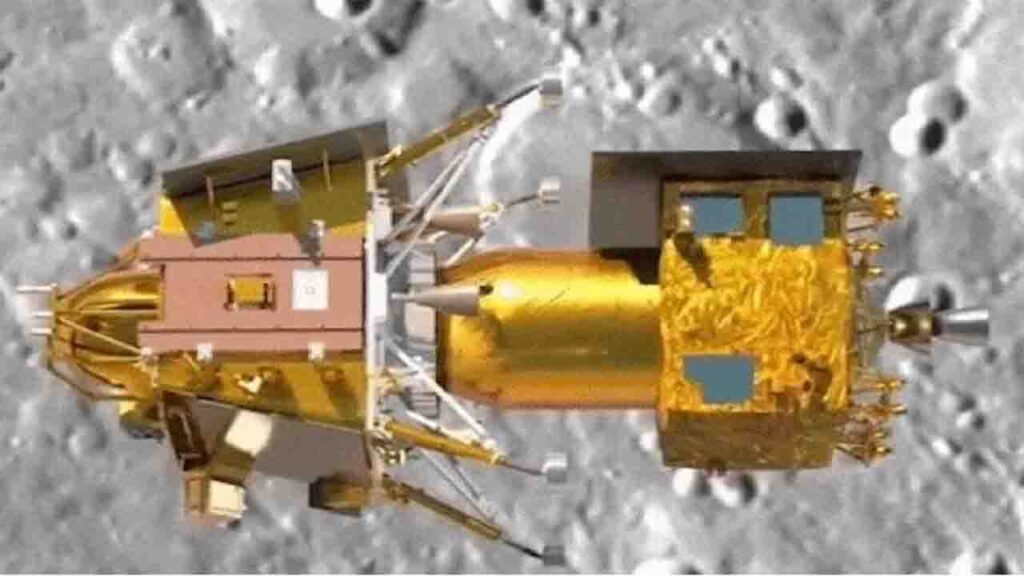India (Commonwealth Union)_ The Indian Space Research Organization (ISRO) has revealed that the Vikram Lander of Chandrayaan-3 has effectively detached from its propulsion module. The separation was humorously acknowledged by the Lander Module (LM) with the phrase, “‘Thanks for the ride, mate!'” According to the announcement, the LM has successfully detached itself from the Propulsion Module (PM) and is expected to transition to a slightly lower orbit after a planned deboosting operation scheduled for the following day at approximately 1600 hours (Indian Standard Time).

The tweet said, “‘Thanks for the ride, mate!’ said the Lander Module (LM). LM is successfully separated from the Propulsion Module (PM). LM is set to descend to a slightly lower orbit upon a deboosting planned for tomorrow around 1600 hours (IST)”. In a separate tweet, ISRO detailed that the propulsion module will persist in its current orbit for an extended period, during which it will conduct a spectroscopic analysis of Earth’s atmosphere and gauge the polarization fluctuations within its cloud cover. Earlier on the same day, ISRO proclaimed that the detachment of the lander from the spacecraft would take place.
A significant milestone in the Chandrayaan-3 mission was reached the day prior when the spacecraft underwent its fifth and concluding orbit maneuver directed towards the Moon’s surface. This maneuver brought the spacecraft into closer proximity to the lunar surface. This achievement marked the culmination of the spacecraft’s lunar-bound maneuvers, paving the way for the forthcoming separation of the lander module, which encompasses the lander and rover, from the propulsion module.
In a previous tweet, ISRO underscored this development by stating that the successful short-duration firing had achieved the intended orbit dimensions of 153 km x 163 km for Chandrayaan-3. With the lunar-bound maneuvers now concluded, attention shifts to the preparations required for the independent journeys of the Propulsion Module and the Lander Module. The tweet said, “Today’s successful firing, needed for a short duration, has put Chandrayaan-3 into an orbit of 153 km x 163 km, as intended. With this, the lunar-bound maneuvers are completed. It’s time for preparations as the Propulsion Module and the Lander Module gear up for their separate journeys”.
Following separation, the lander is anticipated to execute a “deboost” operation to adjust its orbit parameters, aiming for a periselene (closest point to the Moon) distance of 30 kilometers and an aposelene (farthest point from the Moon) distance of 100 kilometers. The upcoming milestone for Chandrayaan-3 is the planned lunar landing at the moon’s southern pole on August 23. Further, the impending lunar landing by ISRO’s Chandrayaan-3 coincides with Roscosmos’ Luna-25 mission in a competition to touch down on the Moon’s south pole. Scheduled for August 23, both missions aspire to achieve this significant feat. The country that attains a successful landing will etch its name as the first to conquer the distant lunar pole.
Discussing the intricacies of the landing procedure, ISRO’s chairman, S. Somanath, emphasized the importance of reducing the lander’s velocity as it descends from a height of 30 kilometers to its final landing position. He articulated the complexity of transitioning the spacecraft from horizontal to vertical orientation during this descent, a challenge that had been faced during the Chandrayaan-2 mission. Somanath emphasized that meticulous simulations, revised guidance designs, and algorithm enhancements have been carried out to ensure proper execution throughout these phases, encompassing optimal fuel consumption, precise distance calculations, and functional algorithms. Somanath said, “The velocity at the start of the landing process is almost 1.68 km per second, but this speed is horizontal to the surface of the moon. The Chandrayaan-3 here is tilted almost 90 degrees. It has to become vertical. So, this whole process of turning from horizontal to vertical is a very interesting mathematical calculation. We have done a lot of simulations. It is here where we had the problem last time (Chandrayaan-2)”.








